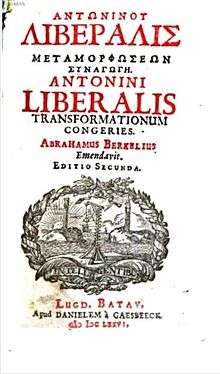Antoninus Liberalis

Antoninus Liberalis (Greek: Ἀντωνῖνος Λιβεράλις) was an Ancient Greek grammarian who probably flourished between AD 100 and 300.
His only surviving work is the Metamorphoses (Μεταμορφώσεων Συναγωγή, Metamorphoseon Synagoge, literally "Collection of Transformations"), a collection of forty-one very briefly summarised tales about mythical metamorphoses effected by offended deities, unique in that they are couched in prose, not verse. The literary genre of myths of transformations of men and women, heroes and nymphs, into stars (see Catasterismi), plants and animals, or springs, rocks and mountains, were widespread and popular in the classical world. This work has more polished parallels in the better-known Metamorphoses of Ovid and in the Metamorphoses of Lucius Apuleius. Like them, its sources, where they can be traced, are Hellenistic works, such as Nicander's Heteroeumena and Ornithogonia ascribed to Boios.[1]
The work survives in a single manuscript, of the later 9th century, now in the Palatine Library in Heidelberg; it contains several works. John Stojkovič brought it to the Dominican convent at Basel about 1437; in 1553, Hieronymus Froeben gave it to Otto Henry, Elector Palatine, who gave it to the Library. In 1623, with the rest of the Palatine Library, it was taken to Rome; in 1798, to Paris, as part of Napoleonic plunder under the terms of the Treaty of Tolentino; in 1816, it was restored to Heidelberg.[2]
Guilielmus Xylander printed the text in 1598; since some leaves have since disappeared, his edition is also a necessary authority for the text.
Many of the transformations in this compilation are found nowhere else, and some may simply be inventions of Antoninus. The manner of the narrative is a laconic and conversational prose: "this completely inartistic text," as Sarah Myers called it,[3] offers the briefest summaries of lost metamorphoses by more ambitious writers, such as Nicander and Boeus. Francis Celoria, the translator, regards the text as perfectly acceptable koine Greek, though with numerous hapax legomena; it is "grimly simple" and mostly devoid of grammatical particles which would convey humor or a narratorial persona.[4]
Tales
- Ctesylla
- The Meleagrids
- Hierax
- Cragaleus
- Aegypius
- Periphas
- Anthus
- Lamia or Sybaris
- The King's Daughters of Emathia
- Daughters of Minyas
- Aedon, the Nightingale
- Cycnus, the Swan
- Aspalis
- Munichus
- Meropis, sister of Agron
- Oenoe
- Leucippus
- Aeropus
- The Thieves in the Idaean cave
- Clinis
- Polyphonte
- Cerambus
- Battus
- Ascalabus
- Metioche and Menippe
- Hylas
- Iphigeneia
- Typhon
- Galinthias
- Byblis
- The Messapians
- Dryope
- Alcmene
- Smyrna
- The Herdsmen, who refused Leto
- Pandareus
- The Dorians, who follow Diomedes
- The Wolf of Peleus
- Arceophon
- Britomartis
- The Fox of Procris
Notes
- ↑ Timothy Renner, "A Papyrus Dictionary of Metamorphoses,", Harvard Studies in Classical Philology (1978:278); many of Antoninus Liberalis' transformations are also into birds.
- ↑ Heidelberg al. gr. 398.
- ↑ Myers, University of Michigan, reviewing Celoria's translation in Bryn Mawr Classical Review, 1994 (on-line text).
- ↑ Celoria, The Metamorphoses of Antoninus Liberalis, 2.
References
- Celoria, Francis, ed. and trans. The Metamorphoses of Antoninus Liberalis: A Translation With Commentary, trans. (London and New York: Routledge) 1992. English with comparative notes. ISBN 0-415-06896-7. This, not offering the Greek text, is the first English translation of this work.
- Irving, Forbes. Metamorphosis in Greek Myth
- Papathomopoulos, Manolis. Antoninus Liberalis: Les Métamorphoses (Paris, Budé, 1968) First translation into French; extensive notes and indices, except on linguistic questions; probably at present the standard text.
- Trzaskoma, Stephen M.. Antoninus Liberalis: three sections from Metamorphoses: Hierax; Aigypios; The Dorians
- Encycyclopaedia Britannica 1911: "Antoninus Liberalis". .